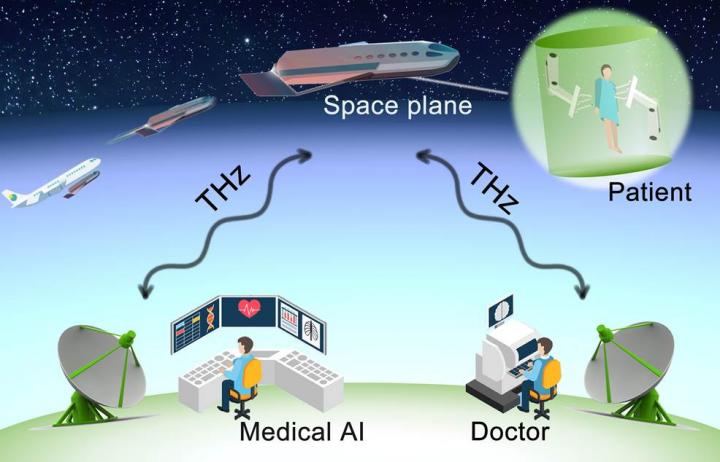Terahertz wireless makes big strides in paving the way to technological singularity

Medical AI and doctors at earth stations could remotely conduct a zero-gravity operation aboard a space plane connected via terahertz wireless links. Credit: ©HIROSHIMA UNIVERSITY, NICT, PANASONIC, AND 123RF.COM
The THz band is a new and vast frequency resource expected to be used for future ultrahigh-speed wireless communications. IEEE Standard 802.15.3d, published in October 2017, defines the use of the lower THz frequency range between 252 gigahertz (GHz) and 325 GHz (the “300-GHz band”) as high-speed wireless communication channels.
The research group has developed a single-chip transceiver that achieves a communication speed of 80 Gbit/s using the channel 66 defined by the Standard. The research group developed a 300-GHz-band transmitter chip capable of 105 Gbit/s [2] and a receiver chip capable of 32 Gbit/s [3] in the past few years. The group has now integrated a transmitter and a receiver into a single transceiver chip.
“We presented a CMOS transmitter that could do 105 Gbit/s in 2017, but the performance of receivers we developed, or anybody else did for that matter, were way behind [3] for a reason. We can use a technique called 'power combining' in transmitters for performance boosting, but the same technique cannot be applied to receivers.
An ultrafast transmitter is useless unless an equally fast receiver is available. We have finally managed to bring the CMOS receiver performance close to 100 Gbit/s,” said Prof. Minoru Fujishima, Graduate School of Advanced Sciences of Matter, Hiroshima University.
“People talk a lot about technological singularity these days. The main point of interest seems to be whether artificial superintelligence will appear. But a more meaningful question to ask myself as an engineer is how we can keep the ever-accelerating technological advancement going. That's a prerequisite. Advances in not only computational power but also in communication speed and capacity within and between computers are vitally important.
You wouldn't want to have a zero-grav operation on board a space plane without real-time connection with earth stations staffed by medical super-AI and doctors. After all, singularity is a self-fulfilling prophecy. It's not something some genius out there will make happen all of a sudden. It will be a distant outcome of what we develop today and tomorrow,” said Prof. Fujishima.
“Of course, there still is a long way to go, but I hope we are steadily paving the way to such a day. And don't you worry you might use up your ten-gigabyte monthly quota within hours, because your monthly quota then will be in terabytes,” he added.
###
This work was supported by the R&D on Wireless Transceiver Systems with CMOS Technology in 300-GHz Band, as part of an R&D program on Key Technology in Terahertz Frequency Bands of the Ministry of Internal Affairs and Communications, Japan.
References
[1] S. Lee, R. Dong, T. Yoshida, S. Amakawa, S. Hara, A. Kasamatsu, J. Sato, M. Fujishima, “An 80Gb/s 300GHz-Band Single-Chip CMOS Transceiver,” IEEE International Solid-State Circuits Conference (ISSCC), 2019.
[2] K. Takano, S. Amakawa, K. Katayama, S. Hara, R. Dong, A. Kasamatsu, I. Hosako, K. Mizuno, K. Takahashi, T. Yoshida, M. Fujishima, “A 105Gb/s 300GHz CMOS Transmitter,” IEEE International Solid-State Circuits Conference (ISSCC), pp. 308-309, 2017.
[3] S. Hara, K. Katayama, K. Takano, R. Dong, I. Watanabe, N. Sekine, A. Kasamatsu, T. Yoshida, S. Amakawa, M. Fujishima, “A 32Gbit/s 16QAM CMOS Receiver in 300GHz Band,” IEEE International Microwave Symposium (IMS2017), pp. 1-4, 2017.
Media Contacts:
Hiroshima University
Public Relations Group
Email: koho@office.hiroshima-u.ac.jp
National Institute of Information and Communications Technology
Press Office, Public Relations Department
Tel: +81-(0)42-327-6923 E-mail: publicity@nict.go.jp
Panasonic Corporation
Global Communications Department
Tel: +81-(0)3-3574-5664 Fax: +81-(0)3-3574-5699
Media Contact
All latest news from the category: Information Technology
Here you can find a summary of innovations in the fields of information and data processing and up-to-date developments on IT equipment and hardware.
This area covers topics such as IT services, IT architectures, IT management and telecommunications.
Newest articles
Faster, more energy-efficient way to manufacture an industrially important chemical
Zirconium combined with silicon nitride enhances the conversion of propane — present in natural gas — needed to create in-demand plastic, polypropylene. Polypropylene is a common type of plastic found…

Energy planning in Ghana as a role model for the world
Improving the resilience of energy systems in the Global South. What criteria should we use to better plan for resilient energy systems? How do socio-economic, technical and climate change related…

Artificial blood vessels could improve heart bypass outcomes
Artificial blood vessels could improve heart bypass outcomes. 3D-printed blood vessels, which closely mimic the properties of human veins, could transform the treatment of cardiovascular diseases. Strong, flexible, gel-like tubes…





















